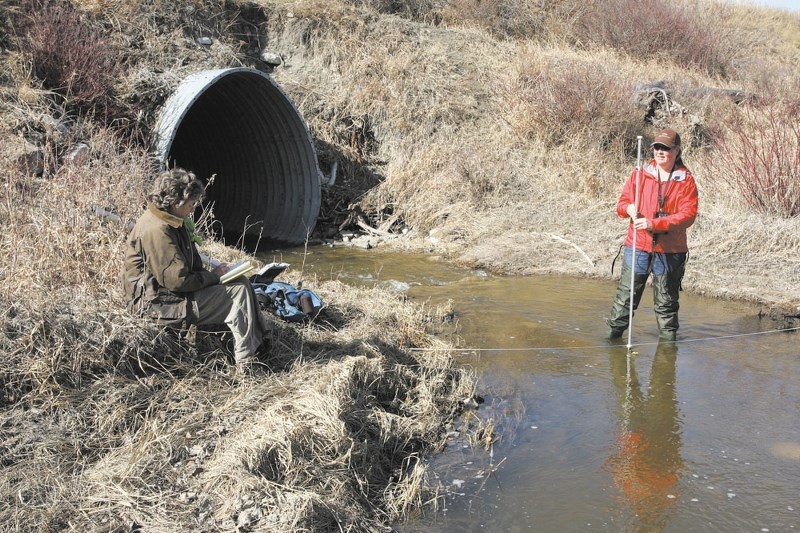In a 5-3 decision at Rocky View County (RVC) council Oct. 28, the county has voted in favour of approving an agreement with the province that would see the county receive $2.35M in grant funding to implement a permanent solution to flooding issues at Cochrane Lake.
Included in the funding is over $1.21M for a ‘water management solution using Horse Creek as an outfall’.
“It’s beyond disgusting,” said Div. 2 county Coun. Jerry Arshinoff, who asked his fellow councillors to delay the decision until council could request from Alberta Environment and Sustainable Resource Development (AESRD) to consider developing a pipe line to the Bow River as part of the permanent solution.
“Why take the solution that clearly is a distant second from the best solution (pumping into the Bow)?” said Arshinoff.
A multitude of concerns have been brought forward by activist groups from both watersheds, Big Hill Creek and Horse Creek, that have continued to receive discharge from Cochrane Lake, following the installation of a much larger pipeline into the Bow River the last week of August. Prior to the pumping into the Bow, the water level was moving down around one inch per week.
Since province-contracted Canadian Dewatering began pumping into the Bow, the water level has descended substantially, as this water body can take in a far greater volume of discharge than the two smaller watersheds.
“We have pumped approximately 1,404 000 m3 of water – roughly 1.4 meters,” explained Jamie Hanlon, AESRD spokesperson.
“There is a remaining 0.6 meters to bring the lake down to the 1,281 meter table.”
Shaun Fielding, vice-president of the Pacific Region for Canadian Dewatering said the pumping has been ‘going very well so far’ and that ‘we will continue to provide our services to the province until we are given further direction’.
The province has given the green light for Canadian Dewatering to install a second high head Godwin pump to ensure 24-hour pumping continues, in the event of a mechanical failure of the current operating pump.
Sarah Leete is a member of Little Creeks and Rough Fescue Appreciation Society (LCARF) — the society that overseas water quality and riparian health of Horse Creek (among other feeder creeks in the watersheds of the Bow and Little Red Deer rivers and in Bighorn, Mountain View and Rocky View County).
Leete remains firm that Horse Creek is not a viable solution for short or long-term discharge from Cochrane Lake and that the Bow River is clearly a better solution.
“There are multiple, immediate impacts on Horse Creek from the water diverted from Cochrane Lake, as well as potential for future impacts from long-term diversions,” explained Leete.
Sandi Riemersma is an environmental biologist with Palliser Environmental Services, who has been contracted by LCARF to conduct baseline water testing at Horse Creek from 2012-2014.
“From data collected in 2013, the water diverted from Cochrane Lake to Horse Creek increased water temperature, conductivity, total phosphorous and total suspended solids above natural,” said Riemersma.
“The degree of impact varies from minor to substantial, depending on stream flow in Horse Creek and the volume of water diverted from Cochrane Lake to Horse Creek.”
Riemersma said that based on her findings, prolonged pumping into Horse Creek may cause problems with the watershed’s ability to assimilate additional nutrients in a stream that contains already higher phosphorous concentrations (phosphorous increases plant and algae growth when present in excess); sustained higher flows at Horse Creek as a result of the discharge may prolong steam bank saturation and increase the potential for erosion; and discharging water into the creek sets ‘an unfortunate precedent for future developments in that area’.
The biologist recommends an environmental impact assessment be undertaken to determine impact of discharge on water quality and aquatic life.
Guy Woods from Bow Valley Habitat Development continues to remain concerned over discharge into Big Hill Creek.
“Unfortunately, the spawning event that typically happens on Ranch House Spring Creek did not happen this fall,” said Woods.
“There were no brook trout redds (egg nests) observed on this small tributary to the Big Hill Creek. Last year, the total trout redd count was 16 redds by this time of the season.”
According to Hanlon, “AESRD has been monitoring the discharges since pumping began…the resulting water quality downstream of the discharge points do not show any appreciable differences than the samples taken upstream of the discharge into the watercourse. This indicates that discharge into these water courses is causing little to no effect on the water quality.”
Arshinoff said he is uncertain why some of his fellow councillors, including Div. 9 Coun. Bruce Kendall, who Arshinoff said tried to prevent him from presenting information as to why the decision should be delayed, are simply writing off a permanent solution to the Bow River as ‘too expensive and too complicated’ when scientific data is indicating that Horse Creek is not a viable solution.
“It’s very conceivable that we’ll be back to where we are in 2-3 years (with Horse Creek chosen as the permanent solution, in the event of heavy rainfall seasons).”




